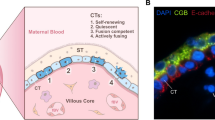Abstract
Binucleate cells in ruminant trophectodermal epithelium are unique in that they form part of the tight junction as they migrate across it, maintaining the ionic barrier seal to the internal milieu of the fetus. Such participation imposes considerable constraints on the cell migration because membrane cannot flow through a tight junction. We report quantitative ultrastructural immunocytochemical evidence for vesicle membrane insertion into the binucleate cell plasmalemma which allows the cells to form a pseudopodium past the tight junction. This pseudopodium increases continuously in area by vesicle insertion and develops a close apposition to the plasmalemma of the fetomaternal syncytium which constitutes the fetomaternal boundary in the placenta of the sheep and goat. Enventually the apposed membranes of the binucleate cell pseudopodium and the syncytium fuse by vesiculation and the cytoplasm and nuclei of the binucleate cell merge into the fetomaternal syncytium. The binucleate cell plasmalemma remaining on the trophectodermal side of the tight junction is blebbed off into, and phagocytosed by, the uninucleate trophectodermal cells between which the binucleate cell passed. This process permits the delivery of the binucleate cell granules to the maternal side of the placenta but none of the fetal molecules expressed on the plasma membrane of the binucleate cells are exposed to potential maternal immunological rejection.
Similar content being viewed by others
References
Allen WR, Hamilton DW, Moor RM (1973) The origin of equine endometrial cups II Invasion of the endometrium by trophoblast. Anat Rec 177:485–502
Atkinson YH, Gogolin-Ewens KJ, Hounsell EF, Davies MJ, Brandon MR, Seamark RF (1993) Characterisation of placentation specific binucleate cell glycoproteins possessing a novel carbohydrate: evidence for a new family of pregnancy associated molecules. J Biol Chem (in press)
Bundgaard M (1984) The three dimensional organisation of tight junctions in a capillary endothelium as revealed by serial section electron microscopy. J Ultrastruct Mol Struct Res 88:1–17
Camous S, Coste V, Guillomot M, Martal J (1991) Demonstration of an ovine conceptus protein related to the bovine serum pregnancy protein (PSP-60) of Mr 60000. J Reprod Fertil [Suppl] 43:301
Chan JSD, Robertson HA, Friesen HG (1976) The purification and characterisation of ovine placental lactogen. Endocrinology 95:65–75
Cho Y, DeBruyn PPH (1981) Transcellular migration of lymphocytes through the walls of endothelial venules in the lymph node. J Ultrastruct Mol Struct Res 74:259–266
Cho Y, DeBruyn PPH (1986) Internal structure of the postcapillary high endothelial venules of rodent lymph nodes and Peyer's patches and the transendothelial lymphocyte passage. Am J Anat 177:481–490
Claude P, Goodenough DA (1973) Fracture faces of zona occludens from tight and leaky epithelia. J Cell Biol 58:390–400
Cramer EB (1991) The ability of leucocytes to cross tight junctions. In: Cereijido M (ed) Tight junctions. CRC Press, Florida, pp 321–336
Gogolin-Ewens KJ, Lee CS, Mercer WR, Moseby AM, Brandon MR (1986) Characterisation of a sheep trophoblast derived antigen first appearing at implantation. Placenta 7:243–255
Kucik DF, Elson EL, Sheetz MP (1990) Cell migration does not produce membrane flow. J Cell Biol 111:1617–1622
Madara JL (1989) Loosening tight junctions, lessons from the intestine. J Clin Invest 83:1089–1094
Mandel LJ, Bacallao R, Zampighi G (1993) Uncoupling of the molecular fence and paracellular gate functions in epithelial tight junctions. Nature 361:552–555
Morgan G, Wooding FBP (1983) Cell migration in the ruminant placenta. A freeze fracture study. J Ultrastruct Mol Struct Res 83:148–160
Russell LD (1978) The blood-testis barrier and its formation relative to spermatocyte maturation in the adult rat: a lanthanum tracer study. Anat Rec 190:99–112
Simionescu M (1980) Structural and functional differentiation of microvascular endothelium. Ciba Found Symp 71:39–60
Singer SJ, Kupfer A (1986) The directed migration of eukaryotic cells. Ann Rev Cell Biol 2:337–368
Takano K, Bogert M, Malamud D, Lally E, Hand AR (1991) Differential distribution of salivary agglutinin and amylase in the Golgi body and secretory granules of human salivary gland acinar cells. Anat Rec 230:307–318
VanMeer G, Simons K (1986) The function of tight junctions in maintaining differences in lipid composition between the apical and the basolateral surface domains of MDCK cells. Eur J Mol Biol 5:1455–1464
Wells B (1985) Low temperature box and tissue handling device for embedding biological tissue for immunostaining in electron microscopy. Micron Micros Acta 16:49–53
Wooding FBP (1982) The role of the binucleate cell in ruminant placental structure. J Reprod Fertil [Suppl] 31:31–39
Wooding FBP (1992) The synepitheliochorial placenta of ruminants: binucleate cell fusions and hormone production. Placenta 13:101–113
Wooding FBP, Brandon MR (1993) Placental cell migration through tight junctions. J Anat 183:187–188
Wooding FBP, Chambers SG, Perry JS, George M, Heap RB (1980) Migration of binucleate cells in the sheep placenta during normal pregnancy. Anat Embryol (Ber) 158:361–370
Wooding FBP, Hobbs T, Morgan G, Heap RB, Flint APF (1993) Dynamics of growth in sheep and goat synepitheliochorial placentomes: an autoradiographic study. J Reprod Fertil 98:275–283
Author information
Authors and Affiliations
Rights and permissions
About this article
Cite this article
Wooding, F.B.P., Morgan, G., Brandon, M.R. et al. Membrane dynamics during migration of placental cells through trophectodermal tight junctions in sheep and goats. Cell Tissue Res 276, 387–397 (1994). https://doi.org/10.1007/BF00306124
Received:
Accepted:
Issue Date:
DOI: https://doi.org/10.1007/BF00306124




